I think about this image a lot.
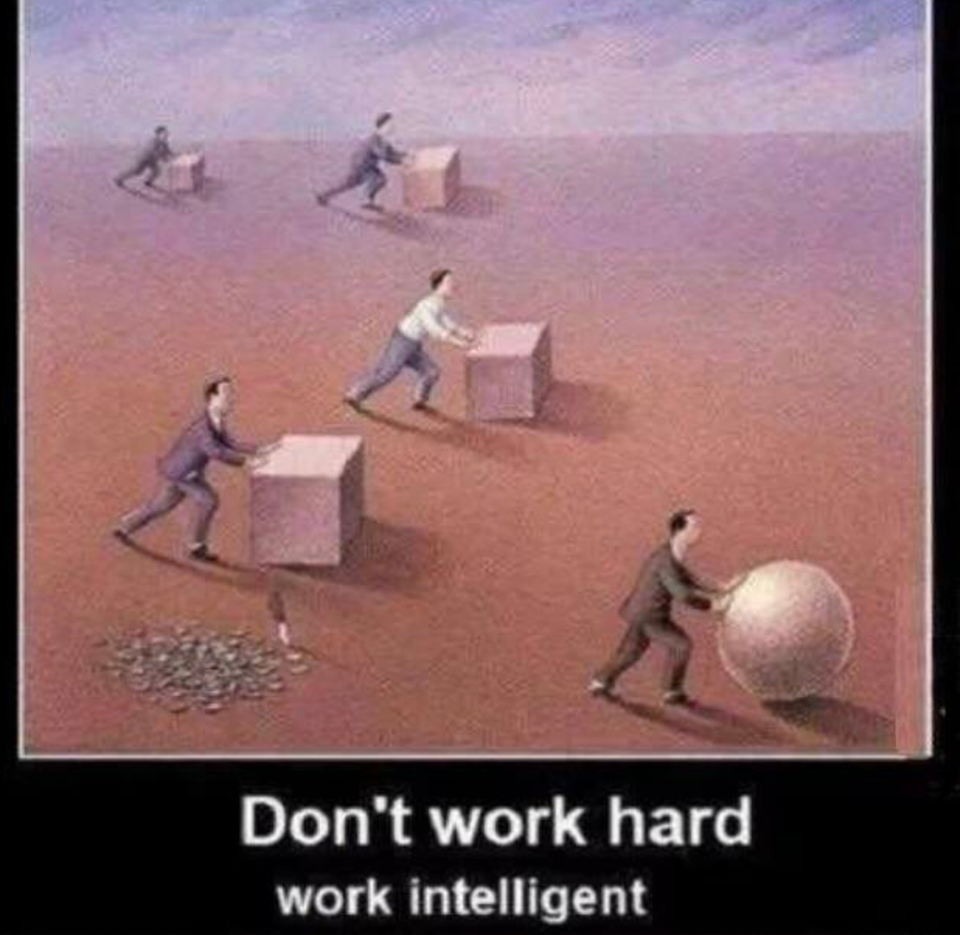
What’s the purpose of the cubes? If they’re blocks in a building, the “intelligent” worker has made his cube useless. He’s going to look like a dumbass when he arrives at the construction site and they say “wow, look at the huge brain on you. We can’t use it. It’s useless.” He should have carved his cube into a cylinder. That way he can roll it on his side, but it can still be used as a load-bearing element.
Speaking of cylinders, and rolling, and uselessness…
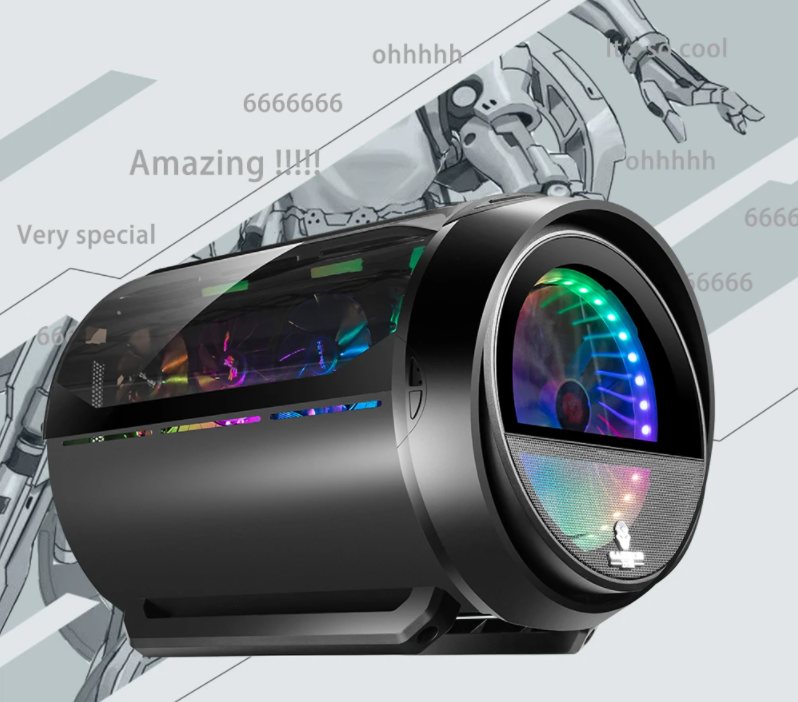
It’s my latest acquisition: a PC case from the wilderness of AliExpress.
This case is advertised around the internet under a half-dozen different names: the GAMEKM Spirit, the GAMEKM Genki Bomb, the TGEARS GAMEKM Genki Bomb Cyclops, the Space Capsule, the JF-TVQJ, and a different company called Vetroo sells an unbranded variant called the V2. I don’t know if they have the rights to the design or if heft-spelled-with-a-t is going on.
It’s clearly intended for Asian teenagers who want a cool-looking PC that doesn’t take up space. Other companies have repeatedly failed to bring cylindrical case designs to market, mostly because they made your computer look like a literal trash can. The GAMEKM SpiritGenkiBombCyclopsJFCapsuleV2 is a different story: it sits on its side (supported by two sled mounts), and its 180 degree acrylic panel (and a 200mm front-mounted fan) encourage you to stuff it with RGB rainbow puke.
This case would be right at home at a Chinese wangba or Korean PC bang: GAMEKM/Vetroo should have made a prebuilt with the latest cheats, hacks, and scripts installed. Do I have to come up with all the good ideas around here?
I didn’t add the “Amazing !!!!!” and “666666”s and so forth, those were on the marketing copy, which is full of lies.
– there is no tempered glass on the case. All transparent elements are acrylic sheet.
– There is no way in fuck you will fit a 165mm CPU cooler in this case. There might be that much internal clearance with a motherboard and CPU installed, but the top of the case is curved. If your cooler is 120mm wide, its height must be approximately √(315^2-120^2)/2 = 145.5mm to fit Remember that you also need fans.
– it ships with a 200mm fan, but it can’t be connected to AuraSync, RGB fusion, and so on. It’s two pin Molex.
– A fan mounted in the position would draw air in to the case, not expel it as the arrows indicate.
– “vertical installation” of the GPU: technically true, but only because your motherboard is flat. You literally just put your GPU in the way you normally would. There’s no other way to install it and I have no idea why they advertised this like it’s a special feature.
– I hope “450*3158*350mm” is a mistake.
– “This little guy can make you a star in your circle of friends”. Very questionable.
It’s “fruity and small”, though. I’ll give them that.
Anyway, let’s build.
* * *
PC builds have a way of going to hell. I can’t count the times my “this will take 2 hours and then I’ll be done” plan has become “this took 8 hours and there’s a gun in my mouth”. This was one of those times.
(Images can be expanded by clicking on them)
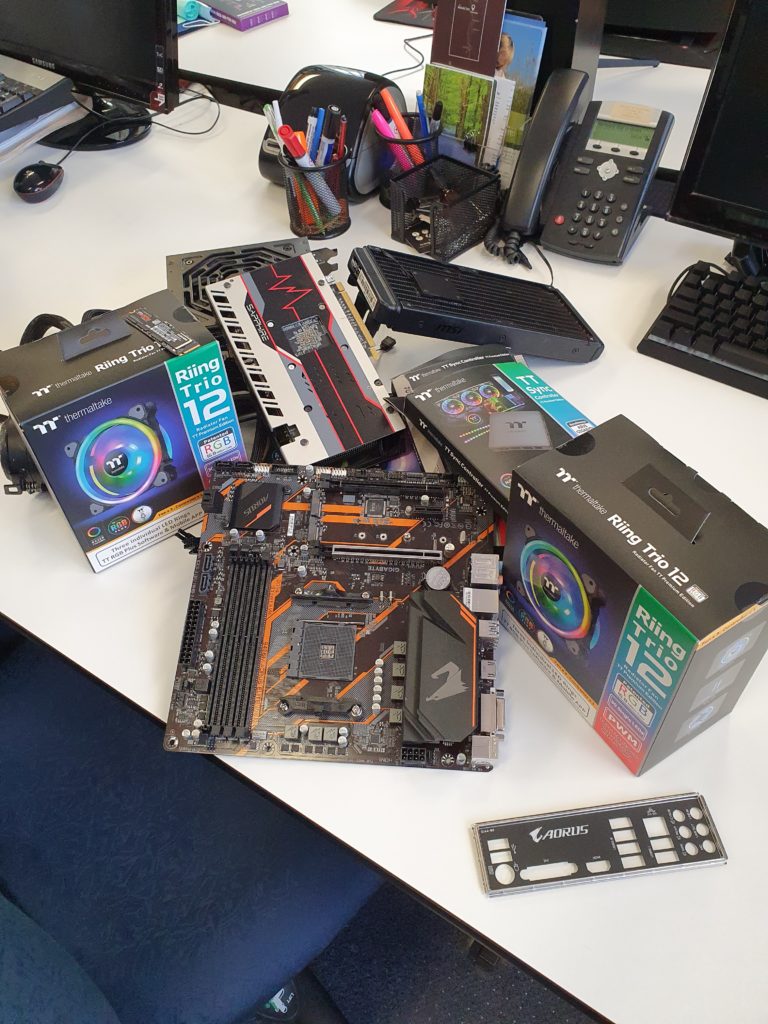
My parts were:
- Gigabyte B550M Aorus Elite AM4 mATX Motherboard
- Ryzen 5 3600 CPU
- AMD Radeon RX 570 (cringe)
- MSI MAG CoreLiquid 240R AIO
- 500GB Samsung 970 NVME m.2 drive
- 2×16 3600MHz GSkill DDR4
- Super Flower modular PSU, not sure on wattage
- 6x Thermaltake Riing Trio 120mm fans
- 1x Thermaltake Riing Trio 200mm fan (replacing the stock GAMEKM fan)
Things started well. I removed the acrylic panel and the two sleds, installed the modular power supply, and routed the cables through the grommets. I’m trying to get things as close to their final configuration as possible – my 24 pin exits near my motherboard’s power socket, and my EPS and VGA connectors terminate near my CPU and GPU power. There are things that are easy when you have an empty case but nearly impossible when the case is full.

I also replaced the 200mm fan, which did not spark joy, with a superior Thermaltake Riing Trio 20. I needed motherboard connectivity. Also, I liked the outer circle on the Riing model fans. They also have a light diffuser bar that smears out the LED hotspots, avoiding the annoying “Christmas lights” effect of many cheap RGB fans.
The chassis is made of SPCC cold-rolled steel. It feels good to touch. There’s something about the tactility of curved metal that goes away when you have straight lines.

Next I installed the motherboard, and then the NVME drive (many of these components, by the way, came from a previous PC.) Wanna know an ancient Chinese secret? Only screw in one of your motherboard standoff screws while you’re working on it. That way your motherboard can bend and flex, allowing you to thread small cables underneath it.
My original intent was to water cool the PC. As the ad copy observes in bastard English, the top of the case supports “cold rows” (liquid cooling, presumably) of 240mm in length. By chance, I had a 240mm radiator I wasn’t using. I had a brilliant idea. I would put two 120mm TT Riing fans on both sides of the radiator block, in push-pull configuration, and mount the entire thing to the top. I’d never seen anyone do anything like that before. I’d make a radiator sandwich!
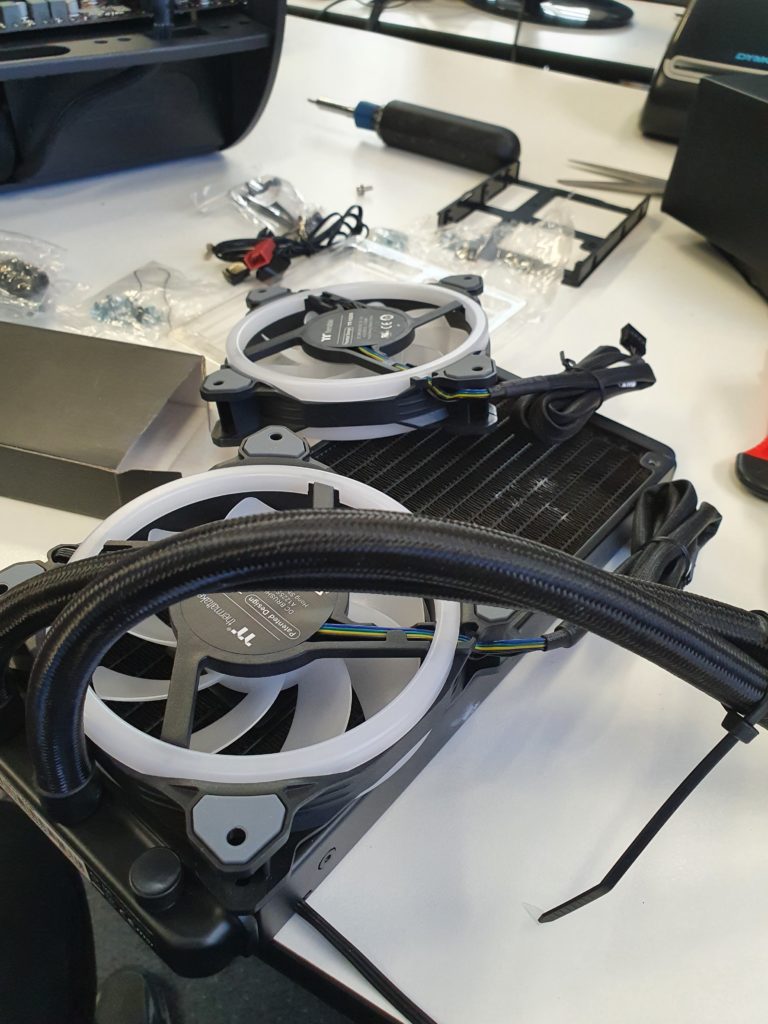
However, often there’s a reason why nobody’s done something before. Immediately, I ran into three problems. The TT Riing Trio fans are extremely thick, and none of the screws I possessed could reach through to the radiator thread (which was annoyingly deep-sunk).

I prised off the rubber pads at the corner of each fan, thinking that this would give me enough clearance. But I soon realized that having screwing two layers of fans onto a fairly thick radiator would make an absolutely massive brick, extending down far into the case. This would impact thermal performance, and additionally block the view (thus largely defeating the purpose of the Genki’s design).
I might still have gone ahead with it…but then I tried to mount the AIO pump to the AM4 bracket, and one of the retention screw literally snapped. I checked for replacements. There were none.
At this point, I abandoned the entire idea of water cooling, grabbed a crappy AMD fan I had lying around, clipped it on, and plugged it into my CPU_OPT.

I put two ThermalTake Riing Trios on the top, sans radiator. An exhaust design wouldn’t have made sense given the downdraft fan two inches underneath them, so I turned them into intakes blowing additional air into the case. The Genki thingo has slots cut into the side so that air can escape. The third Riing Trio went on the back.
Here we were:

Note the scratched paint on the fan bracket. I was already running out of patience, and slapping things together.
Next, I took the fan cables and very carefully escorted them down into the basement of the case, using zipties to keep them tight. That’s not the only way to combine basements and zipties.
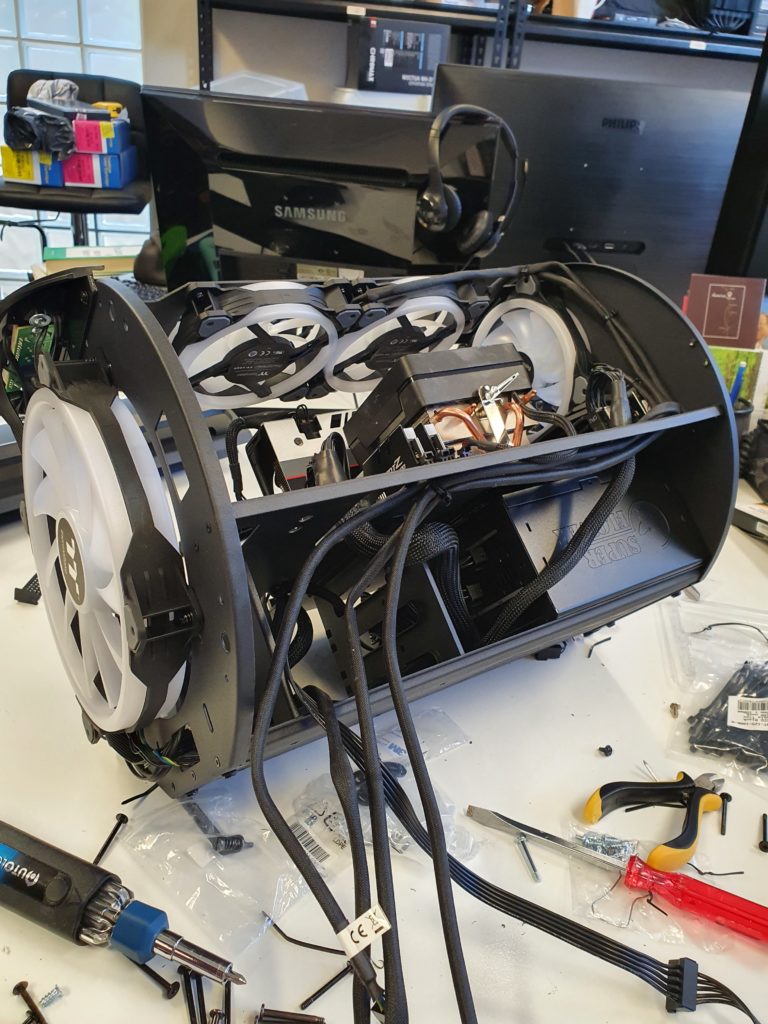
Notice the empty cavity where my hard drives are supposed to go. I have no external HDs, NVME makes them obsolete. I’m reclaiming the space to store cables and other crap.
I turned the computer on and it POSTed. By this point, we were 95% done. I just had to connect the fan cables into the included Thermaltake controller. What could go wrong with such a simple procedure?
I plugged my 20mm fan into port 1 and 2 (it uses two!), my three Riing Trios into ports 3, 4, and 5, and turned the PC on.
The fans didn’t spin. I assumed that there was some driver issue with the controller and USB link into the motherboard…but my computer identified that there was a controller attached. The fans just wasn’t receiving any power. Curious.
I tried several different things (different fans, different motherboard headers, etc). Eventually, I discovered the culprit: Molex cables, and the fact that they are dogshit.
Molex is a cabling standard invented by a company from the 30s that used to make flower pots (I’m not kidding. Look it up.). Although they technically carry more power than the competing SATA standard, they are far easier to break, as they rely on just four crimped or soldered points of failure. I don’t know why Thermaltake expects me to power any device in 2021 with Molex. Probably someone has a spreadsheet showing that updating to SATA power would drop their MMR by 0.4% this quarter and cause the planet to explode and Hitler to come back to life. I don’t know.
Here’s what happened: the female Molex on my PSU had slightly bent pins.

When I plugged the controller in, the misaligned rings failed to accept the +5v and +12v metal prongs, and literally pushed them out of their housing. I destroyed two Molex cables by plugging them in!
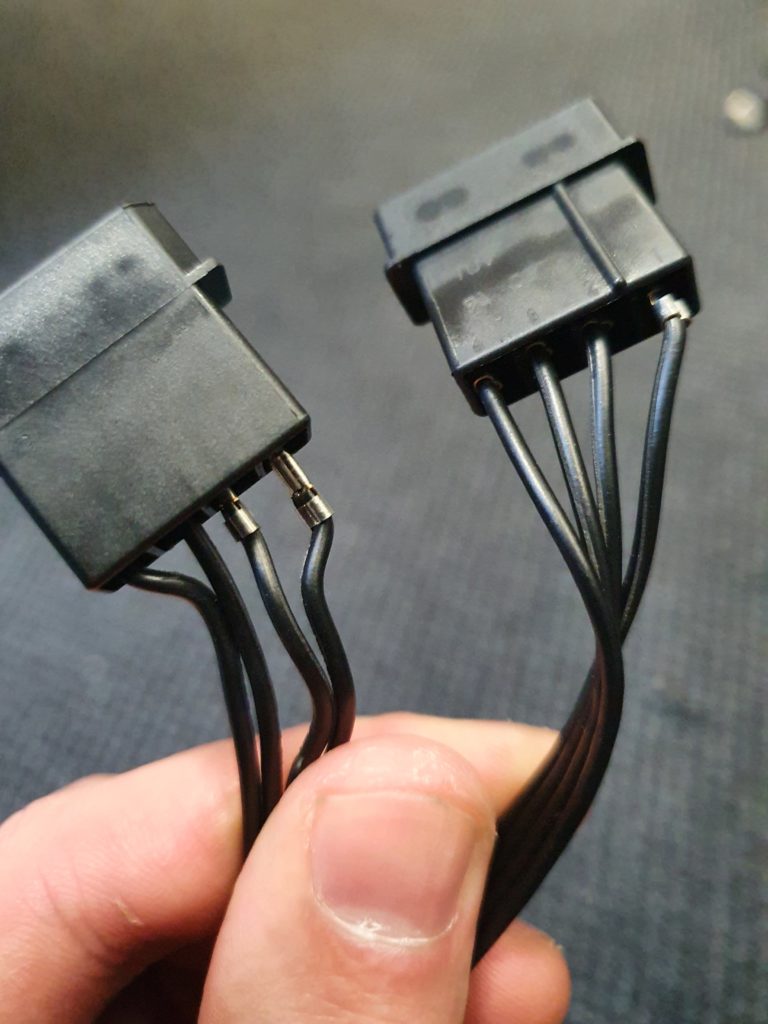
This wasn’t good. I could only use my fans if the controllers had power. And the controllers no longer had a way of receiving power.
Lacking a crimping kit and also lacking tolerance, I did the laziest and most dangerous thing possible: I pulled all of the prongs out of my ruined Molex housing, wrapped them in 400v electrical tape, and shoved them individually into the female Molex.

This seemed to work.

I stuck both my controllers (each set of Riing Trio Plus fans came with one) together with double-sided tape, and stored them directly next to the motherboard. This wasn’t my original plan, but if anything explodes or catches fire thanks to my disastrous solution, at least I’ll be the first to know about it. I might fix this long term. Or I might continue to do nothing.

Everything is now ready to go, and I’m typing using this machine now.


It has unimpressive specs, high noise, high heat, and has a questionable upgrade path. I like it a lot.
With builds, my goal is generally to equal or surpass the test build they used to advertise it. I think I did it with this one. Notice how they have an ugly run of cabling over the exhaust fan? Not on mine.

The case’s name has probably changed six times since I wrote this, so I think I’ll give it one of my own: POLYPHEMUS.
“He [Odysseus] then sailed for the land of the Kyklopes (Cyclopes), and put to shore. He left the other ships at the neighbouring island, took one in to the land of the Kyklopes, and went ashore with twelve companions. Not far from the sea was a cave, which he entered with a flask of wine given him by Maron. It was the cave of a son of Poseidon and a nymphe named Thoosa, an enormous man-eating wild man named Polyphemos (Polyphemus), who had one eye in his forehead. When they had made a fire and sacrificed some kids, they sat down to dine; but the Kyklops (Cyclops) came, and, after driving his flock inside, he barred the entrance with a great rock. When he saw the men, he ate some.
Odysseus gave him some of Maron’s wine to drink. He drank and demanded more, and after drinking that, asked Odysseus his name. When Odysseus said that he was called Nobody, the Kyklops promised that he would eat Nobody last, after the others: this was his act of friendship in return for the wine. The wine them put him to sleep.
Odysseus found a club lying in the cave, which with the help of four comrades he sharpened to a point; he then heated it in the fire and blinded the Kyklops. Polyphemos cried out for help to the neighbouring Kyklopes, who came and asked who was injuring him. When he replied ‘Nobody!’ they assumed he meant no one was hurting him, so they went away again. As the flock went out as usual to forage for food, he opened the cave and stood at the entrance with his arms spread out, and he groped at the sheep with his hands. But Odysseus bound three rams together . . . Hiding himself under the belly of the largest one, he rode out with the flock. Then he untied his comrades from the sheep, drove the flock to the ship, and as they were sailing off he shouted to the Kyklops that it was Odysseus who had escaped through his fingers.
The Kyklops had received a prophecy from a seer that he would be blinded by Odysseus, and when he now heard the name, he tore loose rocks which he hurled into the sea, just missing the ship. And from that time forward Poseidon was angry at Odysseus.”
The gematric and symbolistic parallelism of the tale is hard to ignore. I am Odysseus. Wine represents time: the computer drank all I could give it, and still demanded more. Fire represents electricity: it attracted the giant, but eventually destroyed the giant. I grew tired of the beast’s threats, hardened a spear in the flame, and drove it directly into the 200mm cyclops eye, “blinding it” by destroying the Molex controller cable.
Like Odysseus, I then engineered an embarassing but effective solution to escaping the blinded beast’s clutches. I am now sailing away, and although the beast throws rocks, I will surely prevail.
Polyphemus is a Romanisation of the Ancient Greek Πολύφημος (Polúphēmos). More specifically, πολύ (polú) + φήμη (phḗmē) + -ος (-os), literally “many-voiced”, “much spoken of”. This could be broadly interpreted as “many-titled”, or a reference to the fact that it has so many different names.
This case and I were destined to meet, just as I was destined to slay it. Poseidon’s angry with me, though. Not sure how I’ll get out of that one. But for now, I have Polyphemus.
No Comments »
In ’42, German forces advanced into Russia in the depths of winter. They were confident, thinking their foes weak and in retreat. They were about to be destroyed.
This was 1242, when a young Russian prince lured an army of Teutonic knights and Estonian auxiliaries onto the frozen surface of Lake Peipus and slaughtered them on the ice. Alexander Nevsky’s victory is remembered in Russia as Ледовое Побоище, or Icy Massacre, and might be history’s only naval battle to not involve a single boat. It ended the Teutonic Order’s pretensions upon Novgorodian territory and turned Nevsky into a national hero, sainted in 1547.
Heroes never die. Even when they pass away, something of their essence remains in the national heartwood, inspiring others through the centuries. Seven centuries after Nevsky died, history began to loop back on itself. A prisoner in Germany wrote a book about the future. He was ambitious; mad. He wanted Europe in flames, and a German empire atop the bones of a Russian one. Eight years later that man was both free from prison and Chancellor of Germany. Armies were gathering, and Russia needed heroes once again.
It was inevitable that a film about Alexander Nevsky’s life would be made: a Russian patriot fighting German Catholics was a perfect propaganda coup. Also, Nevsky had died a very long time ago, and we don’t know much about him as a person. This allowed a director freedom to “interpret” him as whoever they wanted, as well as freeing him from troublesome contemporary politics (unlike the Russian generals who had fought Napoleon…on the side of the tsar).
Alexander Nevski was directed by Sergei Eisenstein, with many asterisks and scare-quotes around “directed”. Soviet culture regarded artists as civil servants; if you could write a poem or paint a picture you were expected to do so for the state (and under the state’s supervision). Eisenstein was regarded as suspect when he made the film: he’d spent years living in the west, only returning after what appears to be blackmail. His previous film Bezhin Meadow had failed and earned him a public reprimand. His friends were being arrested, and he soon suspected that the NKVD was shadowing him. Eisenstein probably saw Alexander Nevsky as his last chance, and resolved not to put a single foot wrong. It’s debatable to what extent it’s “his” movie.
It was filmed in 1938 and produced by Mosfilm, with the final cut receiving some additional tinkering by the Party. You could almost give Joseph Stalin an editing and production credit. The picture gained final approval from the State Committee for Cinematography and was released on December 1938, although it hit a snag when when the Molotov-Ribbentrop Pact turned Russia and Germany into momentary allies. Ultimately it was a success, rescuing Eisenstein’s reputation and gaining him a new following abroad. It’s a huge, huge film. Irrefutably part of the canon.
But is it good? Difficult question. As journalist Chet Flippo said after seeing a Queen concert, it “got the job done. I’m just not sure what the job is.”
As a movie it’s a disappointment, featuring rancid acting, a dull story, and sententious touches (medieval Teutons that wear swastikas) that turn its historical setting into chopped liver.
It’s a relic from a bygone age when film was theater’s little brother: get ready for ponderous cinematography, pounding melodrama, shouty brow-furrowing performances, and a total lack of subtlety. Your enjoyment of Alexander Nevski depends on whether you think shots like this are dramatic or silly.

Nevsky is played by Nikolay Cherkasov, whose impression of a wooden board is second to none. His acting skills are suffocated by the role he’s playing: he’s Alexander Nevsky, Great Hero of the Motherland. He doesn’t have a love interest because his love is Russia, he can’t show weakness because Russia has no weaknesses, he can’t fart because that would be like Russia itself farting, etc…
Sergei Prokofiev’s score is acclaimed but I didn’t enjoy it: its shifts from movement to movement (with wildly different moods) sound weird and inorganic next to modern film scores. It’s probably great. I just can’t find a way into it. The subtitled dialog contains deathless Yoda-esque lines such as “They are strong! Hard will it be to fight them!” that hopefully flow better in the original Russian.
Eisenstein (as noted by Roger Ebert) sometimes made films that ascended directly to “great” without actually being good. Alexander Nevsky feels like that sort of movie: it has a spot on the film school curriculum but maybe not in the hearts of many students. It’s a 50 foot colossus with a clown shoes and a big red nose. Huge, important, towering above the landscape…but at the same time, it’s hard to take seriously.
In short, it’s a film of its time. In nearly every scene, shot, and frame, there’s something that jolts me out of the picture. The film at its best is a 1930s version of James Cameron’s Titanic, lavish and expensive, carrying the heft of history, with some innovative and somewhat impressive filmmaking techniques all built around a massive effects-driven set piece. At its worst, it’s patently absurd and laughable.
That’s one way of looking at Alexander Nevsky. The other is as a source of patriotic hope.
The darkness in the West hangs over all of this. You have to remember the circumstances of its production, who would have wanted to see it, and why. Many of Alexander Nevsky’s apparent flaws disappear when you watch it the way you’d listen to a national anthem as a patriot, or attend a church service as a believer.
The broad characterization and black-and-white morality are like anchors, points of stability in an unstable world. The Teutonic Knights are vile (there’s a horrible scene involving infants being thrown into a fire), but so were the real life Nazis. The film runs highlighter over Russian pride and German evil, relating everything back to the USSR’s contemporary circumstances. The historical garb is thinner than rice paper. I don’t think it was meant to be judged as a movie.
Even the film’s camp moments are interesting. At the start we see a Mongol chieftain offering Nevsky a command position in the Golden Horde (which is declined). He’s a silly fat man with a top-knot that looks like Mickey Mouse’s ears.

I am no expert, but I can’t find a photo of a traditional Mongolian (or Chinese) hairstyle that looks like that. It seems unique to the film. I half suspect we’re supposed to think of Mickey Mouse’s ears – the black cap contrasting with his pale skin completes the image. Mickey Mouse (like Alexander Nevski) is inseparable from one particular country: the United States.

Does the Mongol Mouse represent capitalist America in the film? Just as Nevsky represents Russia? That would explain the ominous dialog where Nevski says that although the Mongols are a threat, the Germans are worse and must be fought first. “The Mongols can wait, methinks. We face more dangerous foes.” The difference, Nevsky goes on to explain, is that Mongols are greedy and can be placated with gifts (like capitalists), while the Germans are evil, destroying all that isn’t them (fascists). This anti-fascist angle, it must be said, now looks odd in light of how the Mongols are depicted as grubby savages, while Cherkasov is a tall, blond Aryan superman.
The rest of the film features more blatant pro-Soviet propaganda. Nevsky butts heads with with wealthy boyars (representing kulaks) and priests (representing…) who don’t understand the danger, want to appease the enemy, etc. Fortunately, Nevsky has the people on his side.

This isn’t even pseudo-history, it’s fan-fiction, like a teenage girl making Harry and Draco kiss. The real Alexander Nevsky was a rich aristocrat who took monastic vows. He wasn’t any kind of rabble-rousing working class hero (let alone an anti-capitalist or anti-clericalist). This is Russia’s 1930s political milieu projected seven hundred years into the past. But this is like noticing that Americans depict Jesus as white: it misses the point. Alexander Nevsky isn’t supposed to depict history except in a superficial way. It’s doing something more elemental, issuing marching orders to a nation.
What about the battle scene?
The final third of the movie is eaten up by an extremely long battle involving elaborate staging and hundreds of extras. The rest of the movie seems draped across this set-piece like a threadbare set of clothes (again, Titanic). When the horns blare and the massed columns of infantry advance onto the ice, you forget about everything that happened before. It’s its own self-contained universe.
The scene is groundbreaking – literally groundbreaking, it ends with an army falling through Lake Peipus – and ranks among the most thrilling moments yet seen in a movie. How did it take just forty years to go from Fred Ott’s Sneeze to this? Even today, the battle looks fairly good. Almost any time you see a motion picture featuring a cavalry charge – be it Peter Jackson’s Lord of the Rings, Mel Gibson’s Braveheart, or Sergey Bondarchuk’s Waterloo – it’s trying to look like Alexander Nevsky, consciously or otherwise.
Yes, you can sort of tell that the actors are being filmed under a bright sun on a hot day, but in black and white it’s not obvious. Films have something called “day for night” (a “night scene” that’s clearly not at night). Alexander Nevski went one further: hot for cold. Sand is used in place of snow. Huge sheets of broken glass are used in place of ice. The incredible thing is that it works.
It must have taken a staggering amount of money to film the battle. The costumes, props, and so forth look perfect, and there are hundreds of them. Within a few years, Russians would be facing the Germans with empty rifles, tanks without radios, etc. There’s a grim irony to the fact that (based on the opening weeks of Operation Barbarossa) the USSR was better at fighting a fake war than a real one.
It has some dated elements. Eisenstein wasn’t able to capture the violence and kinematics of an actual battle. Blows are half-hearted. People fall over dead for no reason. Horses are perfectly calm where they should be white eyed, terrified, and spraying foam.
This moment made me laugh. It was like a Keystone Kops gag.

The sheer length of the battle wore me down. Just shot after endless shot of men swinging swords at enemies conspicuously out of frame. I’ll admit that after twenty minutes of this, I wasn’t overjoyed by the prospect of twenty more.

However, the battle ends on an striking visual: the beleaguered Germans collapse the ice with their weight and drown. This is apparently fiction – no contemporary accounts describe such an event – but it’s good, effective filmmaking, breaking the tedium of the battle and providing effective closure to the ice scene. It’s Chekov’s gun in the end. Put a gun on the set, and it has to get used. Put an army on a a frozen lake, and they have to fall through.
Many nations have legends of sleeping champions (Portugal’s King Sebastian, Britain’s King Arthur, Germany’s Frederick Barbarossa) who will return to fight for their homeland in its hour of need. But the atheistic USSR didn’t believe in such fairytales. They forced Nevsky back to life, through the magic of cinema. They probably thought they had to.
It’s a little hard to recommend the entire movie, although the battle is worth watching. Alexander Nevsky does not escape the time its in. You have to take it for what it is, a propaganda tool for a desperate nation facing desperate times. Seen with this in mind, it has a chilling power. Thunderclouds seem to hang above it. Walls of tanks clank in the background. Ahead lay a nightmare: a war so awful that historians disagree not just on how many Russians died, but how many million. The battle is inseparable from the mechanical savagery of Stalingrad and Kursk. The burning children reminds of the Holocaust.
Few films gain so much from their context, and few films have a context this awful. Alexander Nevsky is like a battle standard overlooking a battlefield. It’s just a crude image of a lion, fluttering in the wind. But underneath that lion are rivers of gore, shattered bones, smashed helmets and vambraces, cries of the wounded, and feasting crows.
No Comments »
On March 1954 the annual edition of The Great Soviet Encyclopedia was published by Moscow’s Sovetskaya Entsiklopediya. Under B was a glowing article on BERIA, LAVRENTIY, the great hero.
When Beria was denounced as a spy, tried, and executed later that year, The Encyclopedia’s subscribers received a letter asking them to cut out and return his page. They were sent a replacement article (this one on the BERING STRAIT) which they were to insert into the volume so there’d be no missing page, no jump of numbers, no indication that a change had been made. Beria had been annihilated: cut from history, and the cuts also removed.
In the Soviet Union it was easy to unexist at any time and for any reason. It didn’t matter who you were: a decorated war hero, an inner party member, a useless artist, Stalin’s own daughter. Nobody was safe, nobody was above suspicion. The Soviet Union did scary things to be people, far more unsettling than mangled bodies in a ditch. Execution takes away a future: the USSR tried to take away everything.
By 1952, Soviet historical revisionism was becoming common knowledge. In Foreign Affairs Vol. 31, No. 1, journalist and ex-communist Bertram David “Bert” Wolfe laid out the case for this in embarrassing detail: they weren’t particularly subtle or worried about being caught. Important historical figures weren’t present in the USSR’s textbooks, facts were retooled and adjusted to fit narratives, and in some cases, entire races of people seemingly vanished.
Stalin warps history into a Procrustean bed of his own design […] Deletions from, and insertions into, the original texts of Lenin’s Collected Works as well as his own. The object in this method is to establish his infallibility during and after the October Revolution. […] expunging of the name of Trotsky from all available records. […] Omar Khayyam ceases to be a Persian poet of Nishipur and becomes “a natural product of the Tadzhik people” (a Soviet Republic). Shamil is no longer to be remembered as a hero of the Caucasus who led his people in resisting Tsarist oppression; he is now a “reactionary serving the interests of Britain and Turkey” more than a century ago. […] Companions of Lenin who opposed Stalin became unpersons — their names erased from the scrolls. Nationalities suspected of disloyalty in war, such as the Volga Germans and the Crimean Tartars, became unpeople, — their identities evaporated, and their peoples scattered through the steppes. Material things which offended him, such as museums devoted to native arts instead of to Great Russian benefices, became unobjects, — their contents marked for the trash can. […] When Stalin changes his line or attitude (toward anything under the sun, past or present) the historians must push the new concept backward to include all that went before. The present enemy must be viewed as having been the enemy always. Books, articles, statements, and so on to the contrary, must be purified or burnt. […] To quote the 1934 Stalin in Russia 1952 would be to take one’s life into one’s hands.
Wolfe describes this red-pen attack on reality as “Operation Palimpsest”, which is an odd way of putting it. Palimpsests are old pieces of parchment where the writing has been scraped away so that another layer of text can be overwritten (literally) in its place. In the 21st century, with the aid of chemicals and spectral analysis, we can usually recover the original text. Palimpsests, in other words, are failed acts of removal. The writing is hidden…and yet it remains.
In other words, just like Stalin’s censorship.
As the Beria story illustrates, you can’t just hide something, you also have to hide the act of hiding. It’s no good for a magician to make a rabbit vanish if the audience can see the pulley and wires and trap-door. Political history is replete with examples (Watergate, Lewinski) of bungled coverups that probably did more harm than the original crime, and poorly-done censorship can draw attention to the very thing it tries to cover up.
Below is an infamous pair of photos, synonymous with Orwellian creepiness. They half-depict Nikolai Yezhov (Stalin’s NKVD head from 1936-1938) before and after a history adjustment.

Is it a good fake? I don’t think so. The framing gives it away. No photographer would compose a shot this way: with the subjects packed onto the left and the right showing just empty water. Clearly there’s supposed to be someone on Stalin’s right.
This picture would pass casual inspection, but if you knew that government photographs were prone to censorship, this one would raise red flags (in many senses). Nikolai Yezhov is gone, yet he’s more present than he was before. It’s a method of censorship that reverse-censors, like hiding something beneath a spotlight.
Even if the editor had cropped the photo tighter, it’s possible in theory that Yezhov’s presence could be re-established by a sufficiently advanced machine learning algorithm. We’ve been teaching computers to read emotions from contextual clues since 2003. Perhaps the reverse can happen – an AI reconstructing context from an emotional state. Perhaps there’s something subtle about Stalin’s expression or posture that indicates there’s a man on his right. I’m not sure if it’s possible, but we’re absolutely getting closer to a world where it’s possible.
Technology is the specter at the feast. What will it allow us to do? How soon? Palimpsests appear clean to the naked eye, but to a technological eye the writing’s still there. This artificial gaze (unlike the human one) grows sharper as the years pass: picking out more and more signal from the noise. Historical crimes once considered unsolvable might soon be cracked by increasingly sophisticated uses of forensics and genomics, and so will historical omissions.
Unfortunately, the same fruits of technology will be repurposed to become tools of tyrants and monsters. An advanced deep learning algorithm might be able to recover Yezhov, but a far simpler one would be able to scramble or distort the image to make this impossible, in the same way that a simple freeware program like DBAN can, within seconds, wipe out data in such a way that the entire NSA, given infinite money and years, couldn’t get it back. Entropy’s a bitch. The USSR tried to delete their citizens, but failed because they didn’t have a delete key. The will was there, the technology wasn’t. Seventy years later, a real technological delete key is either coming soon or already here. When it’s finally used, we’ll be the last to know.
Stalin used more crude methods to reframe reality. Ironically, his attempts were rather democratic: he tried to unperson his enemies by public consensus.
Consider the absurdity of the Beria omission. The NKVD wasn’t raiding homes and confiscating copies of the Encyclopedia. They (via Sovetskaya Entsiklopediya) were issuing instructions for citizens to voluntarily censor their own books. They were explaining what needed to be done with full confidence that their instructions would be followed. People were at perfect liberty to leave the page on Beria in the book, but they didn’t think that would happen. After all, history had been revised. A new world existed, one in which Beria didn’t exist. Why would you possibly want an entry for a nonexistent person in your encyclopedia? A lot of decisions make more sense when you let go of assumptions that the truth is unchangeable.
That’s maybe the cruelest, most humanity-defying thing about the USSR in this period: the way they made the people party to their own destruction. It’s not that difficult to crowdsource oppression: East Germany’s Stasi, over the course of its existence, had over 600,000 informants , a substantial proportion of the population. It’s a frightening thought that if we ever disappear, it won’t just be the work of Big Brother but also Big Sister and Big Daddy and Big Mommy and Big Neighborhood TV Repairman. Everyone will collaborate on your unpersoning without shame, perhaps without awareness. They’ll do it out of rightness. A new reality has been imposed where you don’t exist, and thus you don’t. It takes a village to raise a child (as the aphorism goes), and it takes a village to bury a child, too.
No Comments »




























